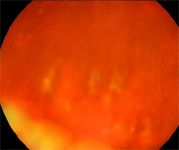Article
Experts discuss evaluation of pars planitis, intermediate uveitis
Experts discuss strategies for diagnosing intermediate uveitis and pars planitis. This is part one of a two-part series.

Key Points
Editor's Note: Intermediate uveitis, also variably called chronic cyclitis, peripheral uveitis, vitritis, and pars planitis, denotes inflammation localized primarily to the vitreous cavity and accounts for 10% to 15% of cases of uveitis seen at tertiary referral centers. Concomitant vitreous opacities called "snowballs" and pars plana exudates referred to as "snowbanking" also may be present. Intermediate uveitis is, therefore, an anatomic description of the primary location of the inflammation and not a diagnosis per se. In fact, there is no gender or racial predilection, and most patients with intermediate uveitis never have an identified cause for their inflammation.
In North America and Europe, sarcoidosis and multiple sclerosis are the most commonly identified systemic associations, with much less frequent cases resulting from lymphoma, Behcet's disease, Vogt-Koyanagi-Harada (VKH) disease, syphilis, tuberculosis, Lyme disease, HTLV-1 infection, Whipple's disease, Sjögren's syndrome, and HIV infection. Unilateral presentation, particularly in children, should raise suspicion of toxocariasis and diffuse unilateral subacute neuroretinitis (DUSN). Failure to respond to corticosteroid therapy should suggest the possibility of a masquerade syndrome, such as lymphoma, retinitis pigmentosa, amyloidosis, or multiple myeloma.
We asked a panel of authorities to discuss their approach to evaluating and treating this common condition. In part one of this two-part article, the panelists discuss strategies for diagnosing intermediate uveitis and pars planitis. In part two, which will be published in an upcoming issue, they conclude with a discussion of management options.

Carlos Pavesio, MD: Pars planitis is a term used to define the idiopathic form of intermediate uveitis, which occurs more often in children and young adults. It is an important distinction because it implies absence of a systemic association and gives a good picture of possible behavior and prognosis.
Russell W. Read, MD: Pars planitis is a form of intermediate uveitis. All pars planitis is intermediate uveitis, but not all intermediate uveitis is pars planitis. The sine qua non of pars planitis is the presence of snowbanks along the pars plana.

Newsletter
Don’t miss out—get Ophthalmology Times updates on the latest clinical advancements and expert interviews, straight to your inbox.




